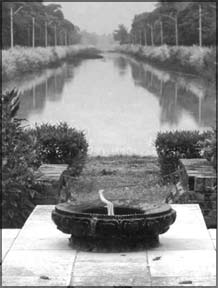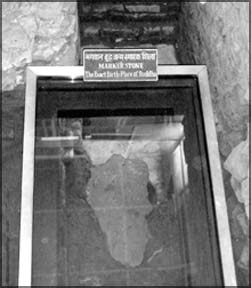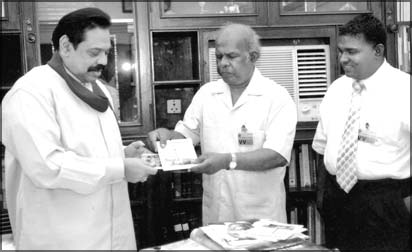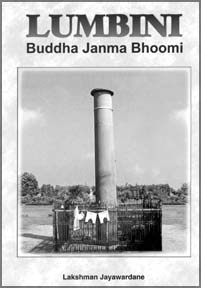|
Buddhist Spectrum
Lumbini
The birthplace of the Buddha:
Rupa BANDUWARDANA
There was exotic flora scenic splendour with wonderfully bloomed,
multi coloured flowers and tender leaves. The trees were amazingly
glittering with flowers fruits and birds, singing joyously in the foot
hills of Himalaya as it was the spring time.
On the full moon day in the month of Vesak, Queen Maya accompanied by
her maids and the palace staff was proceeding from Kapilawasthu to her
parental home in Devdaha for the most magnanimous event in the universe
- the birth of the Buddha the all wise, all compassionate one, the world
teacher Saththa Devamanussanang who emerged for the happiness and
emancipation of all from evil and sorrow.

This was also the first and the greatest event of historic and
cultural significance. This was his last birth. This brought untold
happiness to king Suddhodana and queen Maya who were without children
for 20 long years.
One day in her sleep she saw a dream - a white elephant entering her
womb. Ten months later Buddha to be was born. Lumbini meaning ‘the
lovely’ in Sanskrit located in South Western Nepal in the vicinity of
Himalaya with its rich natural setting described as a beautiful garden,
full of shady Sal trees welcomed Maya Devi and while holding a branch of
a Sal tree the future Thathagatha was born.
Ancient chronicles say that a Bodhi tree sprang up at Bodh Gaya on
this day. The most amazing event was setting foot on seven lotuses which
were in full bloom to welcome the prince saying Aggo Hamasmi Lokassa...
meaning Chief am I in this world. Because he was to be the
Thrailokanatha later.
At a royal ceremony he was named Siddhartha which means ‘wish
fulfilled.’ The Astrologers who came for the naming ceremony predicted
that he will either become a Chakravarti, a universal monarch or give up
worldly life and become a Buddha. He grew up to be a royal prince well
versed in requisite arts.
At 16, he entered matrimony. But it was no bar. At 29, he embarked on
the journey of search of bliss free from Jara, Vyadhi, Marana which he
did succeed for the welfare of the entire humanity. Lumbini, his
Janmabhoomy was the most sacred place where he commenced his journey
putting an end to his journey in Sansara.
Origin and History
Lumbini is the first place associated with the life of the great
master, Sakyamuni Gautama his Janmabhoomy, where he was gifted to the
universe. Buddha himself has mentioned in Mahaparinibbanasutta Lumbini,
as one of the four sacred sites of Buddhist worship not to be missed by
any devotee - a true Buddhist.

Both cities of Rajagir and Kimbulwathpura remained best located
cities in North India standing testimony to the greatness of king
Suddhodana and his righteous rule.
Located close-by, Lumbini had been a beautiful pleasure park
maintained by the Sakyas as well as Koliyas. After Buddha’s time Lumbini
was called Rummindel. A detailed account in Buddhist literature
describes Lumbini as a Pradimoksha - vana filled with fully grown Sal
trees and vivid flower trees with bees and birds not second to India’s
paradise in heaven.
It is said that Sutta Nipata, the Pali Tripitaka and Attakatha refer,
to Lumbini as a fascinating park of natural beauty, well-known Chinese
pilgrims Huian Isang and Fa Hsien described: “Lumbini where the Lord was
born, is a place of heaven on earth and one could see the snowy
mountains amidst a splendid garden embedded with stupas and
monasteries”. Thanks to the great Emperor Asoka who traced the sacred
spot and marked it with a monument, to commemorate the sacred site.
Emperor Asoka - Royal patronage
Indian history reveals that the Mauryan emperor well known for his
effort to preserve the sacred places in his battle against the Moguls
worked hand and rebuilt them. The enemies in their conquering spree had
plundered and razed most of the historic temples. He worked tirelessly
for the propagation of Buddhism.
He is said to have built many stupas enstiring Buddhist relics to
honour the Buddha and preserve them for future generations. On the 20th
year of His reign when emperor Asoka visited, Lumbini had been a
flourishing green village and Asoka is said to have constructed four
stupas and a stone pillars with a figure of a horse on top.
His visit is stated in the pillar. In 1895 a German archaeologist had
discovered the great pillar. Further excavations of the area had shown a
brick temple which depicted the scenes of the birth of Siddhartha.
Maya Devi Temple
The sacred sites at Lumbini stand today to tell us the most
significant unforgettable incidents of the Buddhist era, in the presence
of our own eyes. The sacred temple premises bear testimony to the
Buddha’s birth, serenity and calmness that followed.
The legend says that deities Brahma and Vishnu were there to receive
the new born. To the south of the Maya Devi Temple, there is the famous
bathing pond where Queen Maya is said to have taken a bath before
delivery and Sakyamuni is said to have been given a divine shower by the
deities.
Ladies venerate the statue of Maya Devi to fulfill their wishes of
having children. Devotees never fail to touch it for blessings, so much
so that it has become smaller in certain places. there are small stupas
and Asoka Sthamba in the vicinity. Newly grown Sal trees are around the
place said to bloom once a year during Vesak time.
The site described as a beautiful garden during Buddha days still
retains its traditional charm and scenic splendour, with well laid out
lawns and flower beds by the State government of India refreshing one’s
memories as mentioned in the history and tradition of Buddhism.
Lumbini, the most sacred premises indicated by Sakyamuni, as one of
the four Holy places to be visited was worshipped to our hearts content
in the course of our recent pilgrimage to Dambadiva. It was a very
interesting experience. It was the outcome of the blessings of many a
kind heart.
A book on Lumbini
An essential guide to the Buddha’s birthplace:
DHAMMARUCHI
The birthplaces of sages and saints, prophets and enligthened ones
evoke a kind of holy sentiment to the millions of believers and
followers. Like Jerusalem to Christians and Mecca to Muslims, Ayodhya
and Madura to Hindus, Lumbini, a place in the South Western Terai of
Nepal, the birthplace of the Buddha, ‘Apostle of Peace’ and the ‘Light
of Asia’ is so for the Buddhists. It has become Buddhist pilgrims’
paradise.
|

Lakshman Jayawardane, Chairman, Anagarika Dharmapala
Foundation of India and Counsellor, Sri Lankan Deputy High
Commission, Chennai hands over the first copy of Lumbini;
Buddha Janma Bhoomi to President Mahinda Rajapakse. |
In the Buddhist tourism triangle of India, promoted by its Ministry
of Tourism and Culture, Lumbini is created right on the top. Thanks to
the effort of Emperor Asoka who traced the holy spot and marked it with
a pillar monument, the janma bhoomi of the Buddha is alive today and
crowded with the pilgrims from far and wide.
Thanks also to him, he left some inscription for the posterity,
leaving no room to get locked, in the present day, in disputes and legal
entangles, or the subject be embroiled in controversy.
Located in the plains of South Western Nepal at the foothills of
Churia range, Lumbini and its surrounding area are endowed with a rich
natural setting of domesticable fauna and favourable agricultural
environ.
The region is an exquisite treasure trove of ancient artifacts and
antiquities, dating back to pre-Christian era. The site, described as a
beautiful garden in the Buddha’s time, still retains its legendary charm
and beauty, befittnig the Buddha’s Janma Bhoomi.
For centuries, Buddhists all over the world, knew that Lumbini where
the Buddha was born was somehwere around there. The descriptions of
famous Chinese pilgrims of ancient times, Huian Tsang and Fa Hsien,
indicated to this area saying: “Lumbini where the Lord was born is a
piece of heaven on earth and one could see the snowy mountains amidst a
splendid garden embedded with stupas and monasteries.”
Later Lumbini came to be called Rummindei and Rupendhei. Three
centuries after the Parinirvana of the Buddha, and in the 20th year of
his region, the great Emperor Asoka came to Lumbini all the way from
Pataliputra and erected a pillar there. As a matter of fact, he also
erected pillars all along the route he took from Pataliputra to Lumbini;
some of them still stand.

The Asokan inscription on the pillar reads as follows: “The beloved
of the Gods, the King Piyadessi when he had been consecreated 20 years,
came in person and reverenced the place Buddha Sakyamuni was born.
He caused a stone pillar to be erected (at the Buddha Janma Bhoomi).
As the Lord was born here, in the village Lumbini, he has exempted it
from tax, and fixed its contribution of grain at one-eighth.”
Gradually a large religious establishment grew in and around Lumbini
with many Viharas busy with monks, and with Chaityas and stupas built by
the rich and powerful. However the by the time Fa Hsien arrived at the
Buddha’s birthplace in the fifty century AD, the viharas had been
abandoned and the royal park had become a neglected jungle, it is said.
For several centuries the place was in ruins. However the exact
location remained uncertain and obscure till December 1886 when a
wandering German Archaeologist De Alois A Fuhrer came across a stone
pillar and ascertained beyond doubt it was indeed the birthplace of the
Buddha.
In the 19th century when excavations were carried out some remains of
viharas were discovered and Lumbini once again came to light and saw the
arrival of pilgrims. More digging revealed a stone slab dating to the
Maruiyan period that archaeologists believe marks the exact spot of the
birth of the Buddha.
Lakshman Jayawardane’s attempt to bring out the essentials in a
26-page book is rightly commendable.
Rest and Be Taken
When there is deep abundance
there is nowhere to abide.
There is nowhere to rest
or grasp onto
and yet there is rest
The sky abides
yet it never rests.
Neither can we say that
the sky is not always at rest.
We talk about the sky
as if it were something
as if it actually exists -
and yet we cannot say that
the sky does not exist.
The sky is nothing but
coming and going.
Everything is perfectly spontaneous.
The coming and going arise mutually
instantaneously.
If the true I is asleep
you will miss the point entirely
and you will continue to dwell
in the world of opposites.
So see the two as one
and the one as empty
and be liberated
within the world of duality.
At first it seems
as if begoing follows becoming.
But look even closer
and you will see
that there are only
flashes of lightning
illuminating the empty sky.
Life and death
becoming and begoing
are only words.
In order to save your life
you must see that you die
instantaneously
moment to moment
instant to instant.
Now where are you going to abide?
And where are you not abiding already?
Indeed there is nowhere
to rest your head
and there is nothing but rest.
So let go of all ideas
about permanence and impermanence
about cause and effect
and about no cause and no effect.
All such notions are dualistic concepts.
The Truth of what you are
is completely beyond all duality
and all notions of non-duality,
and yet it includes duality
and non-duality alike.
Like an ocean
that is both waves and stillness
and yet un-definable
as waves or stillness.
The truth of being
cannot be grasped by ideas
or experiences.
Both waves and stillness
are the manifest activity
or your own self.
But self cannot be defined
by its activity
nor by its non-activity.
The truth is all-transcendent
ungraspable, all-inclusive
and closer than your own skin.
A single thought about it
obscures its essence.
The perfume of true life
is right in your nose.
There is nothing you can do
to perceive it
and yet you must do something.
I say:
Rest and be taken.
Rest and be taken.
- ADYASHANTI
ABHIDHAMMA IN A NUTSHELL - XVI:
Meritorious thoughts
Shamika SOYSA
Last two episodes explained evil thoughts or immoral mental states.
This episode and next to come would be on “Meritorious thoughts”, the
“Moral Mental States” or Kusala Chethasika which are associated with
Moral Consciousness (Kusala Chiththa).
Out of 52 Chethasikas the first 13 were Annasamana Chethasikas which
was again divided as Sabba Chiththa Sadharana (7) and Prakirnaka (6).
The second category was Akusala Chethasika and was 14 in numbers which
makes the number of Kusala Chethasikas 25.
These Chethasikas are categorised as below;
* Common to Beautiful - Sobhana Sadharana - 19
* Abstinences - Virathi - 3
* Illimitables - Appamanna - 2
* Wisdom - Panna - 1
Recall 24 types of Kusala Chiththas mentioned in Chiththa Paramaththa.
First 19 of moral mental states are contained in all Kusala Chiththas,
hence they are called as Sobhana Sadharana Chethasikas.
The 19 of them are listed below:
1. Saddha - Confidence
2. Sathi - Mindfulness
3. Hiri - Shame
4. Oththappa - Dread
5. Alobha - Non-attachment
6. Adhosha - Goodwill
7. Thathramajjaththatha - Equanimity
8. Kayapassaddhi - Tranquility of mental states
9. Chiththapassaddhi - Tranquility of mind
10. Kayalahutha - Lightness of mental states
11. Chiththalahutha - Lightness of mind
12. Kayamudhutha - Pliancy of mental states
13. Chiththamudhutha - Pliancy of mind
14. Kayakammannatha - Adaptability of mental states
15. Chiththakammannatha - Adaptability of mind
16. Kayapagunnatha - Proficiency of mental states
17. Chiththpagunnatha - Proficiency of mind
18. Kayujjukutha - Rectitude of mental states
19. Chiththyjukatha - Rectitude of mind
The three Abstinences or Virathi Chethasikas are as follows:
20. Samma Vacha - Right Speech
21. Samma Kammantha - Right Action
22. Samma Ajeeva - Right Livelihood
Two of the Illimitables or Appamanna Chethasikas are:
23. Karuna - Compassion
24. Mudutha - Appreciative or Sympathetic Joy
Finally,
25. Panna - Wisdom
These 25 mental states contains in Kusala Chiththas in various
degrees depending on the situation. From next episode onwards each of
these Chethasika would be described in detail.
Reference: A Manual of Abhidhamma by Ven. Narada Maha Thera
[email protected]
|

